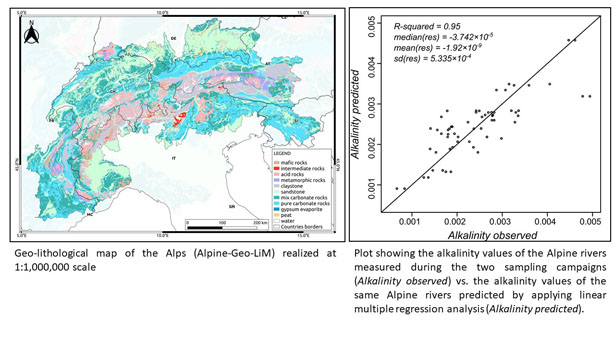A new Alpine geo-lithological map (Alpine-Geo-LiM) and global carbon cycle implications

Published, on GSA (Geological Society of America) Bulletin, a paper – curated by Marco Donnini, Ivan Marchesini and Azzurra Zucchini – that re-evaluates the contribution, in the consumption of atmospheric CO2, of the chemical weathering of arenaceous and conglomerate sedimentary rocks and of igneous rocks. Although to a modest extent, this result has implications for the calculation of the atmospheric CO2 balance both at local and at global scale.
To carry out the estimate we produced a new geo-lithological map of the Alpine region (Alpine-Geo-LiM), derived in the framework of a scientific collaboration between the CNR-IRPI of Perugia and the Department of Physics and Geology of the University of Perugia. The map was used, together with the chemical compositions of the main Alpine river waters (i) to study the relationship between the alkalinity of the Alpine rivers and the lithologies of the corresponding river basins and (ii) to quantify the atmospheric CO2 consumed by the chemical dissolution of carbonate and silicate rocks.

The results of the study confirm that carbonate rocks are highly prone to consume atmospheric CO2. Furthermore, the results show that sandstones (which could have a non-negligible carbonate component) play an important role in the atmospheric CO2 consumption. Another result is that in multi-lithological basins containing lithologies more prone to consume atmospheric CO2, the contribution of igneous rocks to atmospheric CO2 consumption is negligible.
Alpine-Geo-LiM presents several innovations if compared to the lithological maps available in the literature. A first novelty is due to the attention paid to discriminate metamorphic rocks, that have been classified according to the chemical composition of the protoliths. The second novelty is that the procedures used for the definition of the map are made available on the Web to allow the replicability and reproducibility of the product.





